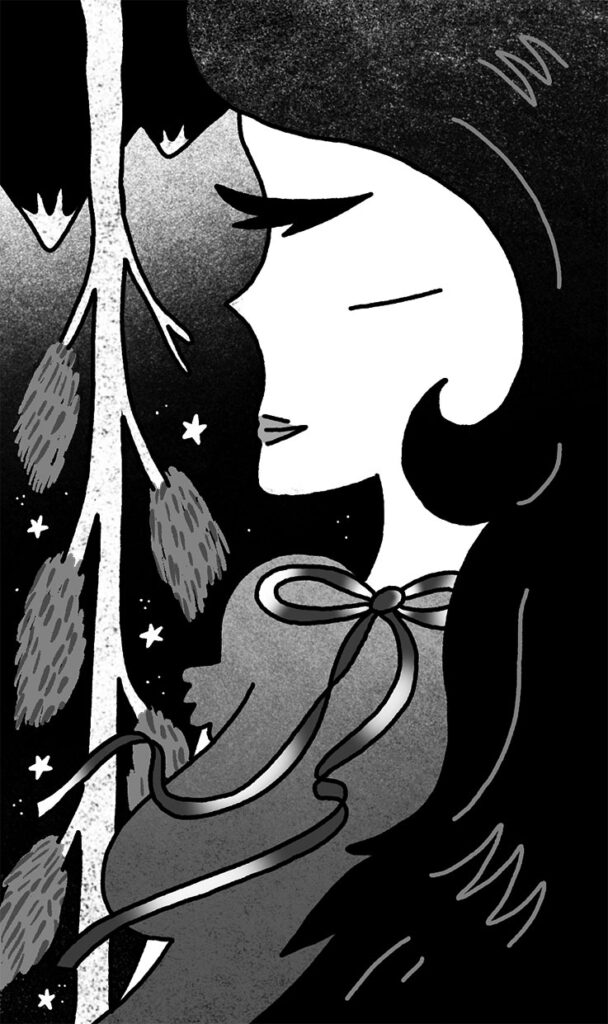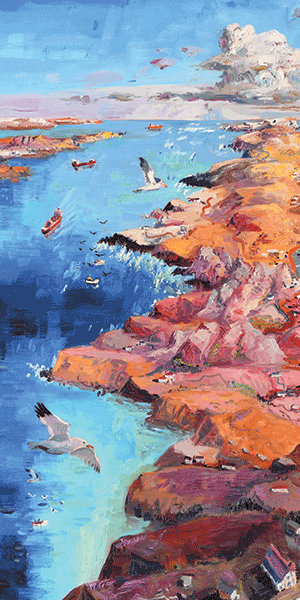An unnamed narrator opens the final chapter of Rachel Cusk’s novel Parade: “Not long ago our mother died, or at least her body did — the rest of her remained obstinately alive.” The balance consists, in part, of their revelations after the drawn-out death of their unknowable, distant parent. Months after her funeral, they visit a museum where an anonymous artist’s paintings give way to thought: “We realised that the death of our mother’s body meant that we now contained her, since she no longer had a container of her own. She was inside us, as once we had been inside her. The pane of glass between herself and us, between the dark of outside and the day of inside, had been broken.”
Parade is a hall of mirrors, a “meeting of darkness and light across shards of broken glass.” In this prismatic, liminal space, Cusk questions how we carry other people forward after death. Like her other works, the seventeenth book from the British Canadian author resists narrative forms and expectations. Characters disappear and reappear across its four lengthy, disparate chapters, “The Stuntman,” “The Midwife,” “The Diver,” and “The Spy.” Cusk writes an unerring meditation on art, legacy, parenthood, and the faulty, distorted panes through which we view one another. Her prose is as disciplined and distant as ever, a distilled force of calm in the chaotic tale that delves into and between the lives of multiple artists, all of whom are reduced to the godlike letter G.
This novel prompts the reader to wonder about representation. In “The Stuntman,” the first G is a celebrated male painter reminiscent of Georg Baselitz. Inspired by watching a tree being felled in the forest, he begins making upside-down paintings — a stylistic change that unmoors his wife. Seeing one of his inversions, “she felt as though she had been hit. The feeling of everything seeming right yet being fundamentally wrong was one she powerfully recognised: it was her condition, the condition of her sex.” With each new painting, culminating in a double portrait of them together, her shock moves toward disdain and hatred.

A novel that upends expectations.
Amery Sandford
Intertwined with this narrative is one that follows an unnamed narrator who, shortly after relocating to a new city, is randomly attacked by another woman. For weeks after the event, unresolved thoughts of her “assassin” assail her. As she wanders into a gallery, she begins to understand the assault. Drifting between knitted sculptures, faceless bodies groping behind glass vitrines, sheaths of fabric hanging suggestively in a bright room, she reflects on her attacker: “Why did it make sense for a woman to hit me? It was as though a violence underlying female identity had risen up and struck.” Together, the storylines pursue the idea of being represented by others. The feeling of being revealed to oneself, however gratifying, is visceral and violent.
Parade is suffused with violence, from physical blows to intimate, psychological conflict. Its second chapter, “The Midwife,” brings the reader into two new alternating plots. In the first, the identity of G, a young female painter, splinters as she ages and becomes more successful. She is no longer just an artist, but also a mother, a wife, and a public persona. She shirks her feminine and maternal duties for years until, in her controlling husband’s absence, she begins leaving her studio door ajar for their daughter. She reconciles the once disparate pieces of herself and, in turn, sees the inevitable demise of her marriage: “G felt the broken fences in herself, where her hatred had surged out and got free.”
Between the episodes of G’s reckoning, an unnamed voice recounts three vacations in a cottage on a couple’s small, strange farm. Gradually it is revealed that the husband has been quietly selling off pieces of their land to pay his debts and that the wife has moved herself and their daughter into a nearby caravan. Both G and the farmer’s wife are broken by their domestic relationships and, ultimately, forced to dismantle their families to address the profound, almost irreparable dissonance within themselves.
At the centre of the book is a dark play on the meaning of exhibition. Beginning in the first chapter, the life work of a sculptor named G — a fictionalized Louise Bourgeois — is being shown posthumously at an airy, light-filled museum. During the opening, an unnamed man jumps over a railing to his death on the marble floor of the atrium. Later that day, the collaborators involved in organizing the retrospective gather for dinner. Their interlocking wine-fuelled monologues become the third chapter, “The Diver.” The gleaming restaurant where they meet is nearly impossible to reach — tucked in an alleyway off winding streets that, after a parade, are covered with broken glass and litter. At the table, the museum director, who witnessed the suicide, laments the derailed order of events: “But nobody knew this man — what did it matter to them? I just wish he had chosen another day.” Between clinking glasses, each character offers unknowing testimony to how our attachments to ideas, art, and people necessarily and brutally obfuscate our immediate surroundings. The life of the absent persona G is more important, and seemingly more knowable, than the anonymous man whose death disturbed the afternoon.
In Parade, the parade has already happened. Characters wade ankle-deep in the aftermath of others — be it their art or their memory. Complete love is as impossible as complete representation, and these twin yearnings deepen the hairline cracks in the necessarily fracturing self. This fragmentation culminates in “The Spy,” in which G, a likely stand‑in for Éric Rohmer, is a writer turned acclaimed filmmaker who works under multiple pseudonyms. He shields his personal identity from the public while also hiding his career and renown from his parents: “He saw himself as a door between them and the whole notion of inner life, and his discovery that this door could be kept shut was both relieving and fateful.” In Cusk’s world, there is no legacy — artistic, familial, or otherwise — that is not in pieces, spread haphazardly among the vessels that carry it, be they parents, children, museums, paintings, books, or readers. We are at once inseparable from and alien to the art, memories, and people we leave behind.
A homage to brokenness, Parade is serrated and shattering — jagged, cut, refracted, and indifferent to being whole. With bold force, Cusk captures something unsettling and true about identity: moments of clarity are as lonely, fleeting, and painful as an unexpected blow.
Emily Mernin is an associate editor at the Literary Review of Canada.

